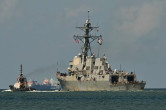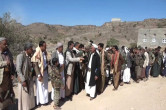الرئيس الإيراني مسعود بزشكيان: العدو يسعى إلى الحيلولة دون نجاحنا ويعمل على تحريض الشعب لكي يتصادم مع النظام
صعدة: إصابة مواطن بنيران العدو السعودي في مديرية شدا الحدودية
سبأ: قضّت المحكمة بتأييد ما قضى به الحكم الابتدائي من إدانة وعقوبة الإعدام بحق ثلاثة من المتخابرين
وكالة سبأ: الشعبة الجزائية المتخصصة تصدر حكمها في قضية خمسة متهمين بالتخابر مع بريطانيا خلال الفترة (2018- 2020)
مصادر فلسطينية: دبابات العدو تطلق نيرانها تجاه حي التفاح شرق مدينة غزة
مصادر فلسطينية: قوات العدو تُطلق الرصاص الحي خلال اقتحام بلدة قفين شمال مدينة طولكرم
مصادر لبنانية: جريحة بانفجار قنبلة عنقودية من مخلفات العدوان الإسرائيلي في أطراف بلدة الماري قضاء حاصبيا جنوب لبنان
أمين عام جامعة الدول العربية يدين زيارة وزير خارجية العدو إلى هرجيسا ويجدد الرفض لأي مساس بسيادة جمهورية الصومال
الصحة اللبنانية: شهيدان جراء غارة للعدو على بلدة كفردونين بقضاء بنت جبيل جنوب لبنان
مصادر فلسطينية: زوارق العدو تطلق نيرانها تجاه شاطئ بحر خان يونس جنوب قطاع غزة








































































